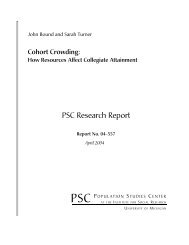Population Ageing and the Well-Being of Older Persons in Thailand ...
Population Ageing and the Well-Being of Older Persons in Thailand ...
Population Ageing and the Well-Being of Older Persons in Thailand ...
You also want an ePaper? Increase the reach of your titles
YUMPU automatically turns print PDFs into web optimized ePapers that Google loves.
Section 6: Policy <strong>and</strong> Programme Responses<br />
age<strong>in</strong>g with respect health, <strong>in</strong>come security <strong>and</strong> social<br />
well-be<strong>in</strong>g. The Thai plan also <strong>in</strong>cludes provisions<br />
for data collection, monitor<strong>in</strong>g <strong>and</strong> assessment <strong>of</strong> its<br />
implementation <strong>and</strong> specifies a number measures to<br />
serve as <strong>in</strong>dicators <strong>of</strong> progress for each <strong>of</strong> <strong>the</strong> Plan’s<br />
five strategies. In this respect <strong>the</strong> Thai plan is also<br />
consistent with <strong>the</strong> Madrid Plan’s call for countries<br />
to review <strong>and</strong> appraise <strong>the</strong>ir implementation <strong>of</strong> its<br />
recommendations. Moreover, many <strong>in</strong>dicators set<br />
forth <strong>in</strong> <strong>the</strong> Plan are consistent with those proposed<br />
by UNESCAP for <strong>the</strong> countries <strong>in</strong> <strong>the</strong> region<br />
(MSDHS 2007).<br />
6.3 Social security system <strong>and</strong> pension plans<br />
Until recently, government <strong>and</strong> state enterprise<br />
employees, who constitute about 9 per cent <strong>of</strong> <strong>the</strong><br />
labour force <strong>in</strong> 2007, were <strong>the</strong> only sector <strong>of</strong> <strong>the</strong> Thai<br />
population with government guaranteed retirement<br />
benefits. The first state-supported pension system was<br />
established <strong>in</strong> 1892 as part <strong>of</strong> welfare provisions for<br />
public servants (Ruengsakul 2003). The 1951<br />
Official’s Gratuity <strong>and</strong> Pension Act <strong>and</strong> its several<br />
subsequent modifications provided a generous<br />
pension <strong>and</strong> o<strong>the</strong>r retirement benefits for government<br />
<strong>of</strong>ficials <strong>and</strong> state employees based on a def<strong>in</strong>ed<br />
benefit system funded by <strong>the</strong> fiscal budget. Civil<br />
servants who worked at least 25 years can chose a<br />
pension or lump sum payment after leav<strong>in</strong>g <strong>the</strong><br />
service. The amount <strong>of</strong> <strong>the</strong> pension could be as high<br />
as 70 per cent <strong>of</strong> <strong>the</strong> last month salary. Those who<br />
worked for 10 years or more but less than 25 years<br />
receive only a lump sum payment. State enterprises’<br />
employees generally receive a lump sum payment upon<br />
<strong>the</strong>ir retirement equal to <strong>the</strong> number <strong>of</strong> years <strong>the</strong><br />
retirees served times <strong>the</strong> last month salary.<br />
Government retirees who choose to receive a monthly<br />
pension, but not those who chose a lump sum<br />
payment, also enjoyed life time health care benefits.<br />
In recognition <strong>of</strong> future trends towards population<br />
age<strong>in</strong>g, both <strong>the</strong> government <strong>and</strong> private sector are<br />
work<strong>in</strong>g towards develop<strong>in</strong>g broader based pension<br />
<strong>and</strong> social security systems to reduce long term<br />
f<strong>in</strong>ancial uncerta<strong>in</strong>ty for <strong>the</strong> older age population. In<br />
1997 <strong>the</strong> Government Pension Fund (GPF) was<br />
established to replace <strong>the</strong> prior system for public<br />
servants. It is a def<strong>in</strong>ed contribution system. Public<br />
servants who jo<strong>in</strong>ed <strong>the</strong> government <strong>in</strong> 1997 or later<br />
are required to be a member <strong>of</strong> this fund. Those who<br />
were civil servants before <strong>the</strong> establishment <strong>of</strong> this fund<br />
could choose ei<strong>the</strong>r to rema<strong>in</strong> with <strong>the</strong> old system or<br />
switch to <strong>the</strong> new GPF. S<strong>in</strong>ce some choose to rema<strong>in</strong><br />
<strong>in</strong> <strong>the</strong> old system, <strong>the</strong> government <strong>in</strong> actuality runs<br />
two systems concurrently. The conditions to receive<br />
a pension or lump sum payment upon retirement are<br />
similar <strong>in</strong> both systems. However, retirees under <strong>the</strong><br />
GPF receive a lower monthly pension but also receive<br />
a lump sum <strong>of</strong> <strong>the</strong>ir contribution at retirement.<br />
A national social security system, enacted <strong>in</strong> 1990,<br />
was launched <strong>in</strong> 1991 to cover <strong>the</strong> private sector.<br />
However, <strong>the</strong> Old Age Pension Fund with<strong>in</strong> <strong>the</strong><br />
system was not set up until 1999. The fund<br />
m<strong>and</strong>ates contributions by employees, employers <strong>and</strong><br />
<strong>the</strong> state for all workers <strong>in</strong> private sector enterprises.<br />
To receive a pension, subscribers must have<br />
contributed for at least 15 years. Thus <strong>the</strong> first<br />
payment <strong>of</strong> old age pension <strong>and</strong> benefits will not be<br />
until 2014. The pension <strong>and</strong> old age benefits<br />
provided by this system are relatively limited. Under<br />
<strong>the</strong> exist<strong>in</strong>g system, members are eligible to receive<br />
pension after leav<strong>in</strong>g work at age 55. The amount <strong>of</strong><br />
<strong>the</strong> pension starts at 20 per cent <strong>of</strong> <strong>the</strong> average salary<br />
<strong>of</strong> <strong>the</strong> last 60 months for those who contributed for<br />
60 months <strong>and</strong> reaches a maximum <strong>of</strong> 42.5 per cent<br />
as <strong>the</strong> length <strong>of</strong> <strong>the</strong> contribution period <strong>in</strong>creases. As<br />
<strong>of</strong> 2006, a total <strong>of</strong> 8.9 million workers are members<br />
<strong>of</strong> <strong>the</strong> social security system.<br />
Besides personal sav<strong>in</strong>gs, o<strong>the</strong>r types <strong>of</strong> old age<br />
<strong>in</strong>surance for <strong>the</strong> private sector <strong>in</strong>clude <strong>the</strong> Private<br />
Sector Provident Fund (PVD) <strong>and</strong> Retirement<br />
Mutual Funds (RMF). The PVD was established by<br />
<strong>the</strong> 1987 Provident Fund Act <strong>and</strong> later underwent<br />
several modifications. It is a privately managed,<br />
voluntary sav<strong>in</strong>gs, def<strong>in</strong>ed contribution type <strong>of</strong><br />
pension scheme. As <strong>of</strong> <strong>the</strong> end <strong>of</strong> 2005, <strong>the</strong>re were<br />
542 provident funds <strong>in</strong> existence, cover<strong>in</strong>g 1.7<br />
60















